No. 315: Updated Outlook, July Employment and Unemployment
JOHN WILLIAMS’ SHADOW GOVERNMENT STATISTICS
COMMENTARY NUMBER 315
Updated Outlook, July Employment and Unemployment
August 6, 2010
__________
Re-Intensifying Depression Foreshadows Great Crises
July Payrolls Fell 131,000, Gained 12,000 Ex-Census Layoffs
June’s 100,000 Ex-Census Payroll Gain Revised to 4,000
July Employment Dropped by 159,000 (Household Survey)
July Unemployment: 9.5% (U.3), 16.5% (U.6), 21.7% (SGS)
__________
PLEASE NOTE: The next regular Commentary is scheduled for, Friday, August 13th, following release of July retail sales and CPI data. An intervening Commentary on liquidity is likely around mid-week.
– Best wishes to all, John Williams
The unfolding renewed decline in economic activity now is likely to be one of the proximal triggers for an even greater systemic solvency crisis, one that will pummel the U.S. dollar, threaten the solvency of the U.S. government and set the stage for a hyperinflation in the United States. In turn, such a crisis would exacerbate the intensifying downturn into a hyperinflationary great depression (see Hyperinflation Special Report).
As suggested by the deterioration and revisions in today’s labor market report, the recently-hailed economic recovery has all but evaporated. Increased impairment of broad U.S. business activity reflects contracting real (inflation-adjusted) liquidity and the ongoing structural impairment of consumer income. Annual contraction in the SGS-Ongoing M3 Estimate nine months ago signaled renewed economic contraction would be underway by around this time.
Market recognition of the re-intensified downturn is spreading, along with recognition of sharply negative implications for the federal budget deficit, for Treasury funding needs, for banking system solvency, etc. In response, the U.S. dollar should come under heavy selling pressure, with eventual heavy dumping of U.S. dollar denominated assets. Coincident with those dollar pressures, the Federal Reserve likely also will find itself the lender of last resort to a U.S. Treasury having difficulties meeting its funding needs. Direct monetization of Treasury debt would result.
Fears of deflation, of renewed recession, of renewed banking troubles already are pushing some to call for new and direct Fed action. That should come, overtly or otherwise, as likely will new bailouts from the federal government of the system, ranging from the unemployed and insolvent states to the banking system, again. As the markets increasingly move away from the dollar in response, however, the risks will be for inflation, not deflation, in terms of consumer prices. With the timing of the renewed economic decline and nascent movement away from the dollar apparently, at hand, I view the next six months to one year to be of particularly high risk for a U.S. dollar panic and resulting spike in domestic inflation, which, in turn, should feed into hyperinflation.
The broad outlook is unchanged, but the timing of the onset of the U.S. dollar crisis is coming into better focus as it moves closer. Holding physical gold and silver, holding assets outside the U.S. dollar (I still like in particular the Australian and Canadian dollars and the Swiss franc), and holding some assets physically outside the U.S. continue to be the primary hedges for those looking to preserve their wealth and assets, to preserve the purchasing power of their U.S. dollars in the extraordinary times ahead.
July’s headline U.3 unemployment rate held at a seasonally-adjusted 9.5%, but not because of a stable employment environment. To the contrary, continued shrinkage of the labor force (as tallied for U.3) in absolute terms, as well as proportionate to the population, reflects an increasing number of longer-term unemployed giving up looking for work and moving from the headline U.3 category into the short-term discouraged worker category included in the broader U.6 unemployment rate. The July U.6 unemployment rate, however, also held even with June, at a seasonally-adjusted 16.5%. What appears to be happening here is that as short-term discouraged workers pass their first year as such, they are dropping off the unemployment rolls into the officially-ignored long-term discouraged worker category, where the SGS-Alternate Unemployment Rate notched higher to 21.7% in July (see discussion in Commentary No. 308). I still am working on a series of charts detailing the universes of both the short- and long-term discouraged workers. At such time as those charts are introduced, I also plan to review the substantial negative impact of illegal immigration on the national employment and unemployment circumstance.
Payroll Survey. The Bureau of Labor Statistics (BLS) reported today (August 6th) a statistically-significant, seasonally-adjusted July 2010 jobs loss of 131,000 (down by 228,000 before prior-period revisions) +/- 129,000 (95% confidence interval). Net of the included layoffs of 143,000 intermittent and temporary census hires, July payrolls gained a statistically-insignificant 12,000 jobs (a loss of 85,000 before prior-period revisions). The reported gain in private sector payrolls was 71,000 (up by 37,000 before prior-period revisions) for the month, which masked a plunge in other government jobs that brought the total ex-census gain to that 12,000 figure.
Against July’s total jobs loss of 131,000, a jobs gain net of census impact of 12,000, and a jobs gain of 71,000 in the private sector, June showed a revised monthly total jobs loss of 221,000 (previously a loss of 125,000), a jobs gain net of census impact of just 4,000 (previously 100,000), and a jobs gain in the private sector of 31,000 (previously an 83,000 gain).
Based on the patterns of hiring and firing temporary workers for the 2000 census, census layoffs from the 2010 census will continue to have major negative impact on reported payroll changes through September.
From peak-to-trough (the peak month was December 2007; December 2009 is the likely short-lived trough of the current cycle), payroll employment declined by a seasonally-adjusted 8,363,000 jobs, or 6.1%.
The pace of reported monthly change has turned relatively less negative versus year-ago comparisons of sharp month-to-month declines. The year-to-year contraction in total nonfarm payrolls flattened to a decline of 0.01% (a contraction of 0.16% net of surviving census hires), from June’s revised 0.14% (previously 0.05%) aggregate annual contraction, and a revised 0.39% (previously 0.30%) annual contraction for June net of census effects.
The current annual declines have narrowed from the post-World War II record 4.96% decline in July 2009. The July 2009 decline was the most severe annual contraction seen since the production shutdown at the end of World War II, which reflected a trough of a 7.59% annual contraction in September 1945. Disallowing the post-war shutdown as a normal business cycle, the current annual decline remains the worst since the Great Depression.
The long-term graph of year-to-year payroll change reflects the numbers as reported, with no adjustment for census hiring variations. The second graph, however, shows the year-to-year detail both with and without the census hires.
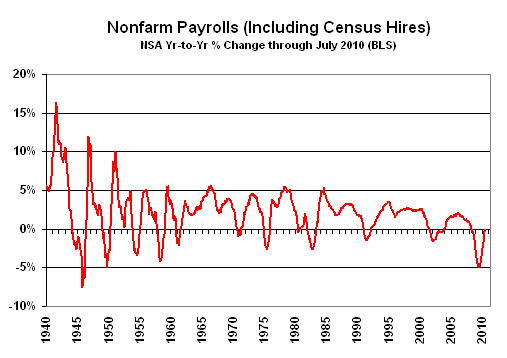
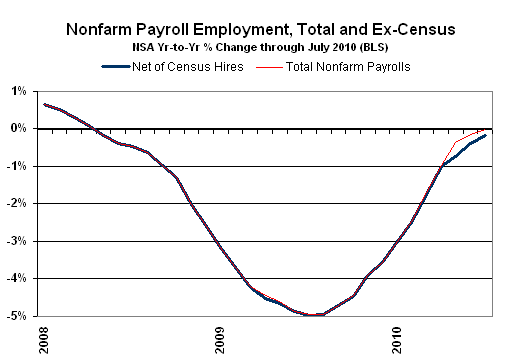
Birth-Death/Bias Factor Adjustment.Where the BLS cannot measure the impact of jobs loss and jobs creation from employers starting up or going out of business, on a timely basis (within five years), such information is estimated by the Birth-Death Model. Unusual birth-death activity continued in July 2010, with the monthly birth-death adjustment adding 16,000 more jobs relative to what it did in July 2009, a pattern contrary to what would be suggested by recent BLS reporting difficulties that understated declines in payroll employment.
Based now on the "assumption" of economic recovery, the bias factors used in the last four months of payroll reporting have been 27.8% ahead of what they were reset to after the most recent and disastrous benchmark revision. Positive assumptions — commonly built into government statistical reporting and modeling — can become self-fulfilling prophesies, with "stronger" economic data being reported as a result of happy guesstimates.
Historically, the Birth-Death Model biases have tended to overstate payroll employment levels — to understate employment declines — during recessions. These flaws were confirmed by the nature of the BLS’s massive downside benchmark revision published with the January 2010 jobs report, where the BLS had indicated that underlying assumptions to the Birth-Death Model were missing significant jobs losses due to business failures that the BLS could not measure.
Although the upside bias had been scaled down some from the year before as a result of the reporting errors, the Birth-Death Model survives and remains a major distorting factor in monthly payroll reporting. The unsupportable premise that jobs created by start-up companies in this downturn have more than offset jobs lost by companies going out of business, continues. So, if a company fails to report its payrolls because it has gone out of business, the BLS assumes it still has its previously-reported employees and adjusts those numbers for the trend in the company’s industry.
Further, presumed additional "surplus" jobs, created by start-up firms, get added on to the payroll estimates each month as a special add-factor. These add-factors are running at about 50,000 per month, at present. I estimate this monthly bias should be negative by 200,000 or so, on average. Since it is not, the BLS continues regularly to overestimate monthly growth in payroll employment by roughly 250,000 jobs. Such misreporting, however, will not be corrected until the next benchmark revision is published in February 2011, well after the November elections.
That said, the unadjusted July 2010 bias was a monthly addition of 6,000 jobs, versus a subtraction of 10,000 jobs in July 2009, and against a monthly addition of 147,000 jobs in May 2010.
Household Survey. The usually statistically-sounder household survey, which counts the number of people with jobs, as opposed to the payroll survey that counts the number of jobs (which includes multiple job holders), showed a seasonally-adjusted monthly employment contraction of 159,000 in July, following a reported decline of 301,000 in June, irrespective of census jobs impact. As with last month’s data, the series appears to be experiencing major distortions from inappropriate seasonal-adjustments for temporary census worker employment. Since a number of the part-time census workers already would be counted as employed due to other part-time or full-time employment, accurately quantifying the impact of census employment variations on unemployment is not possible.
Where I fully expected that some portion of the census layoffs would have at least pushed the unemployment rate minimally higher in the last two months, such did not happen. Nonetheless, sharp upside movements in the unemployment rate in the next several months still should be seen as these distortions are reversed, and as the intensifying economic downturn takes its toll. Also, as discussed earlier, an increasing numbers of longer-term unemployed counted in U.3 unemployment are rolling into the short-term discouraged worker category, with a portion thereof rolling into the long-term discouraged worker category.
The July 2010 seasonally-adjusted headline U.3 unemployment rate held at 9.51% +/- 0.23% (95% confidence interval). July’s unchanged level from June’s 9.51% just as easily could have come in at 9.3% or 9.7%, given the statistical-confidence interval of the series. Not seasonally adjusted, July’s U.3 unemployment rate rose to 9.7% from 9.6% in June.
July U.6 unemployment held at a seasonally-adjusted 16.5% (fell to 16.4% unadjusted) versus 16.5% (16.8% unadjusted) in June.
In 1994, during the Clinton Administration, "discouraged workers" — those who had given up looking for a job because there were no jobs to be had — were redefined so as to be counted only if they had been "discouraged" for less than a year. This time qualification defined away the long-term discouraged workers. The remaining short-term discouraged workers (less than one year) are included in U.6.
Adding my estimate of the excluded long-term discouraged workers back into the total unemployed, unemployment — more in line with common experience as estimated by the SGS-Alternate Unemployment Measure — notched higher to about 21.7% in July, from 21.6% in June, reflecting some of the unemployed who became short-term discouraged workers a year ago disappearing into the long-term discouraged category. The SGS estimate generally is built on top of the official U.6 reporting and tends to follow its relative monthly movements. See the Alternate Data tab for a graph and more detail.
As discussed previously, while 21.7% unemployment might raise questions in terms of a comparison with the purported peak unemployment in the Great Depression (1933) of 25%, the SGS level likely is about as bad as the peak unemployment seen in the 1973 to 1975 recession. The Great Depression unemployment rate was estimated well after the fact, with 27% of those employed working on farms. Today, less that 2% work on farms. Accordingly, for purposes of a Great Depression comparison, I would look at the estimated peak nonfarm unemployment rate in 1933 of 34% to 35%.{{end}
GDP Inflation Spike in Second-Quarter GDP. For those readers who queried as to why the GDP inflator for second-quarter GDP was up at an annualized 1.8%, versus an annualized 0.7% contraction in the CPI-U for the same period, the answer is in declining prices for imported oil, exacerbated by seasonal adjustments. In the GDP calculation, exports are added on top of the other consumption numbers, while imports are subtracted as an economic negative. This process reverses the impact of inflation or deflation in the import category, where declining imported oil prices ended up spiking GDP inflation.
GDI Revisions Show Earlier Onset to the Recession. In the double-entry bookkeeping of national income reporting, Gross Domestic Income (GDI) is the income-side equivalent to the consumption-side Gross Domestic Product (GDP). Since GDI and GDP are surveyed separately, though, they rarely are the same, with equality forced by the addition or subtraction of a "statistical discrepancy" to the GDI side of the equation. Where the GDP is the headline number so carefully massaged to meet financial-market and political needs, I like to use the cleaner GDI, net of the statistical discrepancy, as a tool for assessing what really is being picked up in the national income numbers.
Following are three graphs. The first two show annualized quarterly growth rates first of GDP and then GDI, both before and after the annual revisions. The third graph shows the current reporting of the annualized quarterly growth rates for GDI and GDP. Please note that second-quarter 2010 GDI will not be estimated until next month.
While the GDI had been showing a pattern of more protracted and weaker growth than the GDP, revisions to the GDI now clearly show recession beginning in first-quarter 2007, instead of fourth-quarter 2007 as formally timed by the National Bureau of Economic Research (NBER), official arbiter of U.S. recessions.
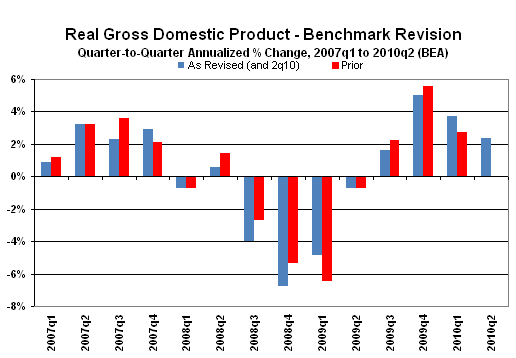
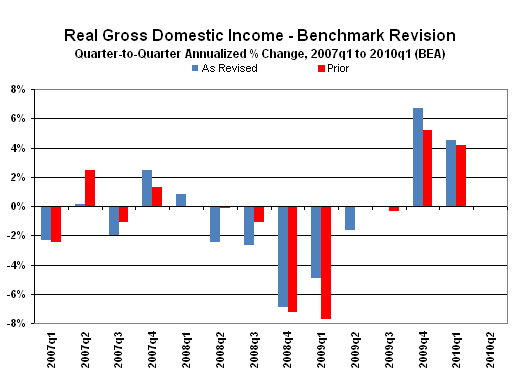
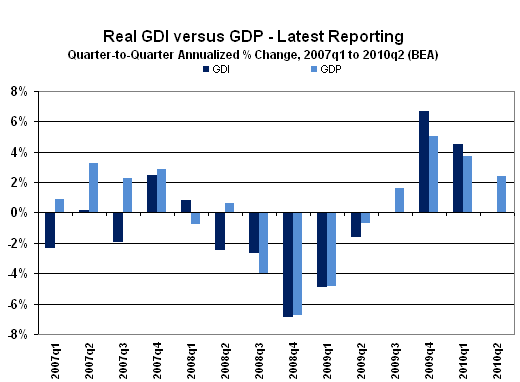
The following updated graph plots annual real M3 growth versus periods of recession formally recognized by the NBER. It includes approximate annual real contraction in the SGS Ongoing-M3 Estimate as of July 2010. The July M3 estimate used here is an annual real contraction of roughly 6.7% versus a 6.9% contraction in June and a 7.9% contraction in May. Such reflects a combination of softer inflation rates as well as year-ago comparisons with weakening broad money growth. Details will be discussed in the next Commentary, which will review the broad liquidity outlook and the money supply circumstance. The formal preliminary estimate for the SGS Ongoing M3 Measure for July will be posted this weekend of August 7th on the Alternate Data page for M3.
At present, the pace of annual contraction in nominal July M3 is on track to hit 5.4%, versus 5.9% in June, reflecting a flattening of month-to-month change and annual comparison against a pace of slowing growth in the year-ago period. Such is qualified by the ongoing choppy nature of recent weekly reporting in the major M3 components.
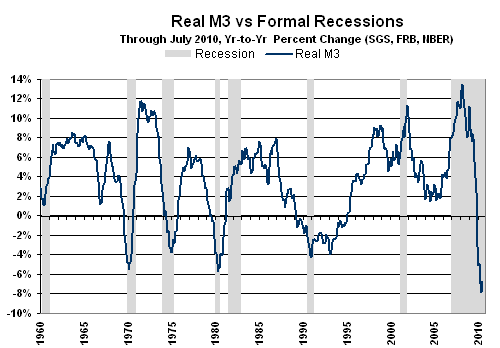
Week Ahead. Given the unfolding reality of a weaker economy (or re-intensifying downturn) and more serious inflation problems than generally are expected by the financial markets, risks to reporting will tend towards higher-than-expected inflation and weaker-than-expected economic reporting in the months ahead. Increasingly, that will be seen in economic reporting net of prior-period revisions.
Trade Balance (June 2010). Due for release on Wednesday, August 11th, the June trade balance would affect the first revision to second-quarter GDP, if results showed unusually large improvement or deterioration. I would look for deterioration, with a possible downside revision to GDP growth.
Retail Sales (July 2010). Due for release on Friday, August 13th, July retail sales are likely to disappoint what should be relatively soft expectations, again reflecting the re-intensifying economic downturn. Month-to-month change should be negative after adjustment for inflation, confirming contracting economic activity.
Consumer Price Index — CPI (July 2010). Due for release on Friday, August 13th, the July CPI-U should surprise likely consensus expectations on the upside. Although gasoline prices were flat month-to-month for July (per the Department of Energy), a major swing in seasonal factors will give gasoline prices and the CPI a monthly boost, beginning to catch up on energy-based inflation that had been muted by seasonal factors of recent months.
Year-to-year inflation would increase or decrease in July 2010 reporting, dependent on the seasonally-adjusted monthly change, versus the 0.10% adjusted monthly gain seen in July 2009. I use the adjusted change here, since that is how consensus expectations are expressed. To approximate the annual inflation rate for July 2010, the difference in July’s headline monthly change (or forecast of same) versus the year-ago monthly change should be added to or subtracted directly from June 2010’s reported annual inflation rate of 1.05%.
__________